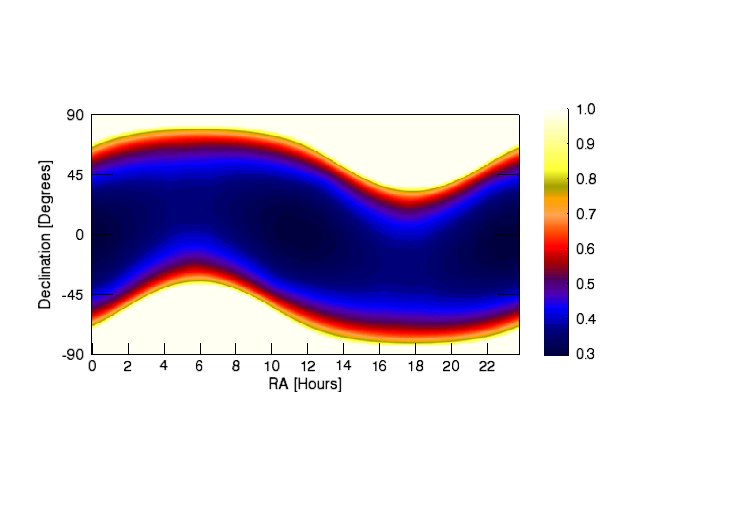The areas of the sky accessible to the Herschel telescope are determined by a number of constraints applicable to Sun, Earth, Moon and other bright solar system objects. In particular, the following constraints are applicable through the mission:
Sun-S/C-LoS angle in the S/C XZ plane (Solar Aspect Angle or SAA) of 60°.8 to 110° for normal operations. Please notice that the allowed range has been reduced with respect to the original one (60° to 120°) since in the extreme SAA range ('warm' attitude range, SAA in the 110° to 120° interval) a noticeable pointing performance degradation (larger APE and pointing offset drift) due to thermo-elastic effects has been observed. Moreover, this degradation persists even if the S/C is brought back to 'cold' attitude until the structure settles back in the original position. Nevertheless, if deemed unavoidable, short (less than 1 hour) observations in the 'warm' SAA range (110° to 120°) can be scheduled at the end of the operational days. The observer should be aware that in such cases, a degradation of the pointing accuracy is very likely. Similarly, post launch a small change was made to the extreme range of permitted of solar aspect angles to limit it to a maximum range from 60°.8 to 119°.2.
Maximum roll angle of ±1°
In addition, the following extreme Earth and Moon angles do occur across the mission (to be taken into account for straylight considerations):
Sun-S/C-Earth angle of 37°
Sun-S/C-Moon angle of 47°
In order to avoid straylight pollution and also for safety reasons (to prevent large fluxes of light from reaching detectors), the nominal half-cone exclusion angles listed in Table 2.3 apply to observations towards major planets.
Table 2.3. Nominal exclusion angles (half-cones) for observation towards major planets
| Instrument | Mode | Mars | Jupiter | Saturn | Instrument |
|---|---|---|---|---|---|
| Critical | |||||
| a. SPIRE has determined that, while Jupiter and possibly Saturn will not damage the instrument, they would render it inoperable for a significant period (possibly even an entire OD) | |||||
| b. For SPIRE PACS parallel mode both the SPIRE and PACS restrictions apply. | |||||
| c. HIFI wishes to avoid straylight pollution when observing fainter objects with a SSO close to the instrument LoS. The instrument will not be harmed by the presence of a major SSO in the FoV and will, in fact, even use Mars as its primary calibrator. | |||||
| d. During slews, the detectors are ON (photometry, spectroscopy or parallel mode). | |||||
| e. During non-SSO PACS observations. PACS may well wish to observe these SSOs directly. | |||||
| SPIRE | Slew | 15 arcmin | 15 arcmin | 15 arcmin | Yesa |
| Pointing | 1.5 deg | 1.5 deg | 1.5 deg | Yesa | |
| HIFI | Slew | 36 arcmin | 36 arcmin | 36 arcmin | Noc |
| Pointing | 36 arcmin | 36 arcmin | 36 arcmin | No | |
| PACS | Slewd | 4 arcmin | 4 arcmin | 4 arcmin | No |
| Pointinge | 1.5 deg | 1.5 deg | 1.5 deg | No | |
The time windows when a fixed or moving target or list of targets are visible can be calculated with HSpot. The tool provides an easy way to check in which time intervals a source is visible during the mission. The visibility calculation does not yet take into account the avoidance cones around Jupiter, Saturn and Mars described above.
The sky visibility for each date has been determined by the launch date (14th May, 2009) and the orbit of the satellite. Considering a nominal duration of the operations, all areas in the sky are visible at least 30% of the time. The sky visible region moves slowly on a daily basis. The two snapshots at the bottom of Figure 2.8 illustrate the typical sky visibility differences after a 3 month interval; although this is calculated for an different launch date to the actual one, the graphic remains a valid representation of the effect.


Figure 2.8. Top: The sky visibility across the sky as a fraction of the total hours through the Herschel mission, represented as a colour scale (shown at right) where black represents 30% visibility and white represents permanent sky visibility. Bottom: sky visibility for two sample dates. Shadowed areas represent inaccessible sky areas.